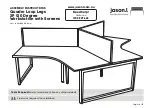
GCP5000 (GCE) INSTALLATION, CALIBRATION AND SYSTEM OPERATIONAL CHECK
_________________________________________________________________________________________________________
6-21
SIG-00-22-02 JUNE 2022 (Revised September 2022)
Version: B.1
Table 6-4 GCP5000 (GCE) Operational Tests
Step 1
Check PSO for:
Open receive wire
Crossing activates
Step 2
PSO Enables & AND 1 Enable input(s), if these features are used:
Crossing activates when each PSO Enable input or AND 1
Enable input (controlling the crossing) is de-energized or opened
from the far end of the circuit.
Pickup Delay time is correct when input closes.
Step 3
“Vital Comms” operation using Spread Spectrum Radio or Ethernet
link, if these features are used:
Expected behavior occurs when Vital Comms message bits are
de-energized
Step 4
Wrap logic, if this feature is used:
Wrap logic WRP is displayed on the Main status screen for each
corresponding wrapped track (when Wrap inputs are energized
as seen on the system I/O view).
WRP is removed from the corresponding track on Main status screen
when:
Corresponding PSO with wrap is shunted or
Corresponding wrap input is de-energized
Measure Wrap pick-up delay from the time the wrap input is
energized until the WRP is displayed on corresponding PSO status
screen. Verify the Pickup Delay time (minimum of 5 seconds).
Step 5
Traffic Signal Preemption, if this feature is used:
The preempt output de-energizes:
If using Simultaneous Preemption: When the PSO receiver is
occupied the crossing activates.
If using Advance Preemption: When the PSO receiver is
occupied the crossing activates after the programmed advance
preemption delay.
.
When used, Advance Preempt IP input open causes Advance
Preempt Output to de-energize and activates the warning devices
after the Advance Preempt Delay Timer times out. (Observe input on
I/O view).
When used, Preemption Health IP input open activates warning
devices immediately (without advance preempt Delay time interval).
(Observe input on I/O view).
When used, Traffic Signal Health open initiates simultaneous
preemption, rather than advance preemption, upon train detection.















































